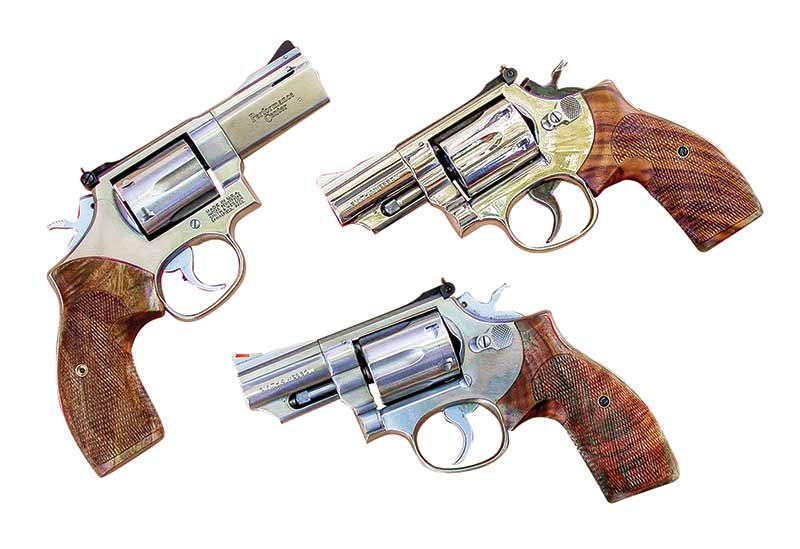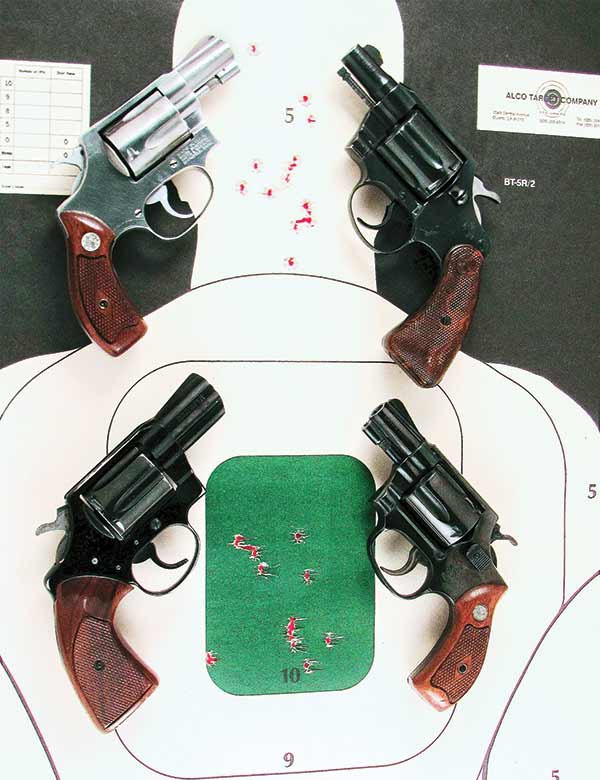Today they are most often known as pocket revolvers or sometimes snub-guns. However, several eons ago in the pre-politically correct days when I was a teenager, they were known as belly guns. This has several meanings such as “easy-to-conceal,” “for use at very close distances” and even “shot from the hip or at ‘belly’ level.” For our purposes here we will define BBBG (Big Bore Belly Gun) as a single- or double-action sixgun with a barrel shorter than 4″ and chambered in a cartridge more powerful, and with a larger bullet diameter, than the age-old .38 Special.
At mid-century, most belly guns were thought to be 2″ .38 Specials such as the Colt Detective Special or the Smith & Wesson Chief’s Special. These were guns of choice as backup for peace officers and quite often the main armament of detectives. They also fit well in pocket, purse, backpack, kit bag and hunters often carried them should the chance of a grouse present itself. I have found the Chief’s Special to be invaluable for carrying in situations where it was absolutely imperative it not be known I was armed.
Beginnings
Every Western movie, whether “B” or “TV,” gives the impression every Western town was filled with men openly carrying firearms. Actually, the opposite was true as many towns had ordinances against the carrying of firearms, so quite often sixguns were carried quite discreetly and out of sight. Walker/Dragoons and the follow-up Colt 1860 Army were not that easy to conceal so gunfighters had to correct the situation.
The Mormon gunfighter and peace officer, Porter Rockwell, may have been one of the early proponents of Big Bore Belly Guns as he often cut back the barrels of Dragoons and 1860 Army .44s to make them easier to conceal and faster to reach if needed.
El Paso Marshall Dallas Stoudenmire also favored an 1860 Army with the barrel cut way back to 2-7/8″ and converted to fire .44 cartridges. James Hume of Wells Fargo, who captured Black Bart, also carried a cut-down Colt 1860 .44 as a hideout gun.
When Colt brought out the Single Action Army in 1873, it had a 7-1/2″ barrel. Most sixgunners were satisfied with the power afforded even if the Colt was quite large. However, enterprising shooters on both sides of the law decided they could make improvements. Many examples have been found with the barrels cut back as far as 2″ and some even went so far as to remove the barrel altogether. These sixguns were for very up close and personal situations.
It did not take Colt long to start offering Sheriff’s or Storekeeper’s Models without ejector rod housings and very short barrels. This would continue into the 2nd Generation with the 3″ Sheriff’s Model .45s and then as the 3rd Generation came along both .45 and .44 examples were offered.
In 1877 Colt brought out their first double-action sixguns with the .38 Long Colt Lightning and .41 Long Colt Thunderer. These were also soon offered without ejector rods and short barrels for easy concealment. Meanwhile Merwin, Hulbert & Co. offered their superbly engineered Pocket Army in .44-40 and in both single- and double-action versions.
Ranger Up
The Texas Rangers in the first half of the century were often quite flamboyant. They definitely dressed the part with brush jacket, fancy boots, a white Stetson and especially took great care in selecting their sidearms. Manuel T. “Lone Wolf” Gonzaullas was such a ranger and he had several sets, pairs of sidearms along with suitable holsters. At times he carried a pair of Smith & Wesson .44 Specials, a pair of .45 ACP 1911s with the front of the trigger guard cutaway and also a pair of Colt Single Actions with the front of the trigger guard removed.
He also went for Big Bore Belly Guns in a big way. A pair of 2″-barreled Colt Single Actions were covered with Indian signs and fitted with grips having inlaid semi-precious stones. He also used a highly customized Colt 1917 .45 ACP with a shortened butt, 2″ barrel with ramp front sight and the front of the trigger guard cutaway. He always made the most impressive sight.
Changes
Smith & Wesson changed the face of sixgunning forever in 1935 with the introduction of the original .357 Magnum. The first .357s produced had 8-3/4″ barrels and examples were sent to Elmer Keith and J. Edgar Hoover of the FBI. Keith wrote his up in the American Rifleman and had the barrel cut back to 6-1/2″ for easier handling. It was just about this time the FBI officially began to be armed and the .357 Magnum had the barrel cut back to 3-1/2″, even with the ejector rod.
To my sixgunning eyes this is the most serious-looking revolver ever produced. The FBI also went for it in a big way with agents such as Hank Sloan and Jelly Bryce soon carrying 3-1/2″ S&W .357 Magnums. Jelly Bryce received a lot of attention for his fast draw exploits with the new short-barrel .357 Magnum and was featured drawing and shooting in Life magazine in 1945. Many police departments followed suit with Smith & Wesson providing hundreds of 3-1/2″ .357 Magnums to departments around the country.
Perhaps the most famous 3-1/2″ Magnum was purchased in 1935 by an active-duty lieutenant in Hawaii. Six years later we were at war and the lieutenant was soon to be a general and was easily spotted by his troops as his symbol of leadership was a pair of ivory-stocked sixguns. One was a blued 3-1/2″ Smith & Wesson .357 Magnum while the other was a fully engraved, nickel-plated Colt Single Action he had purchased in El Paso in 1916 before accompanying Black Jack Pershing into Mexico after Pancho Villa.
George S. Patton called the .357 Magnum his “killing gun,” however, there is no record of him ever using it in such a way. He did take out two of Villa’s officers with his .45 Colt in 1916.
Today
Today 3-1/2″ .357 Magnums are highly desired by both shooters and collectors. There are three basic categories, namely the original Registered Magnums, the Pre-Model 27 versions, and the Model 27s. I have the last two, however, the first version has escaped me and is definitely now too valuable and at too high a price for me to search out.
Chief Border Inspector Bill Jordan began lobbying Smith & Wesson for a lighter .357 Magnum. He felt, correctly, metallurgy had improved to the point where they could make a smaller .357 Magnum. He suggested the Military & Police as the basic platform. Smith & Wesson responded using special heat-treated M&P frames with full-length cylinders to fill out the frame window and a heavy 4″ barrel. Bill Jordan called the new “Combat Magnum” the answer to a peace officer’s dream.
However, just as with the original long-barreled .357 Magnum, there were shooters wanting the Combat Magnum made easier to conceal. Once again, Smith & Wesson listened and cut the original barrel length of the Combat Magnum from 4″ to 2-1/2″ and put a round butt on the grip frame. The result in the 1960s was the smallest BBBG available.
For carrying all day, the 4″ Combat Magnum cuts about 1/2 lb. off of the weight of the original .357 Magnum and this makes a huge difference at the end of the day. The 2-1/2″ version is even better at this. In fact some peace officers began to carry the 2-1/2″ Model 19/66 as their backup gun.



